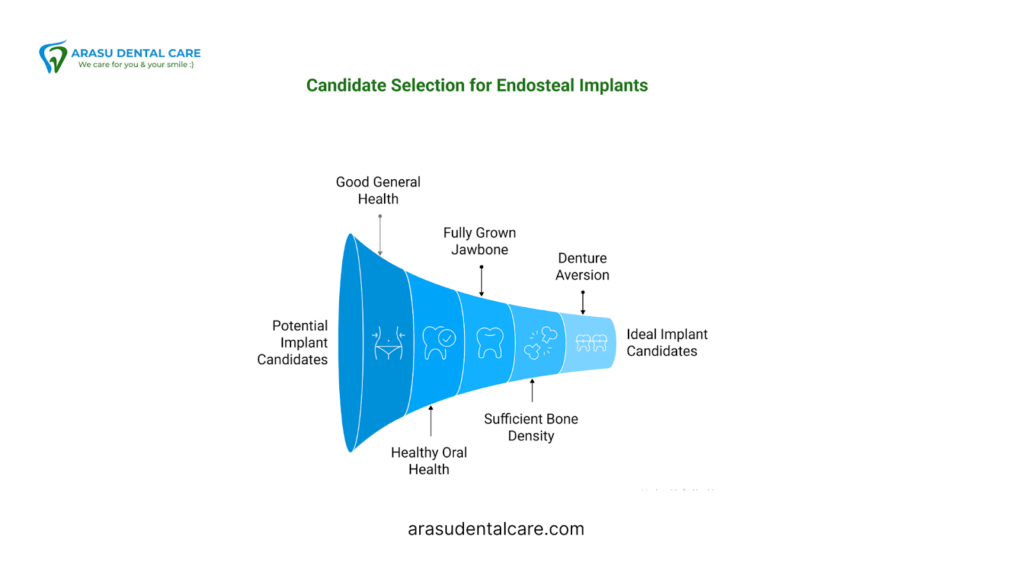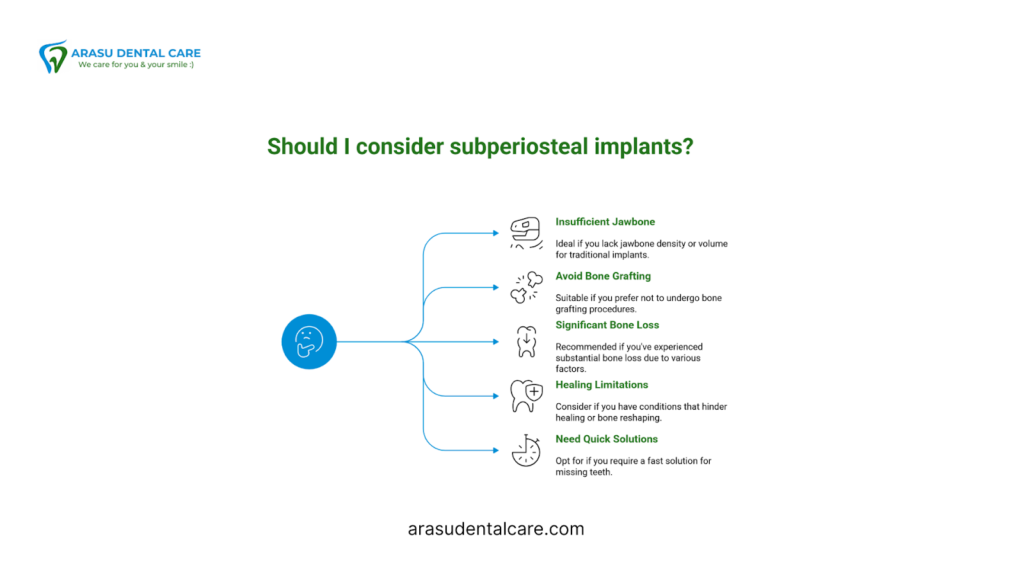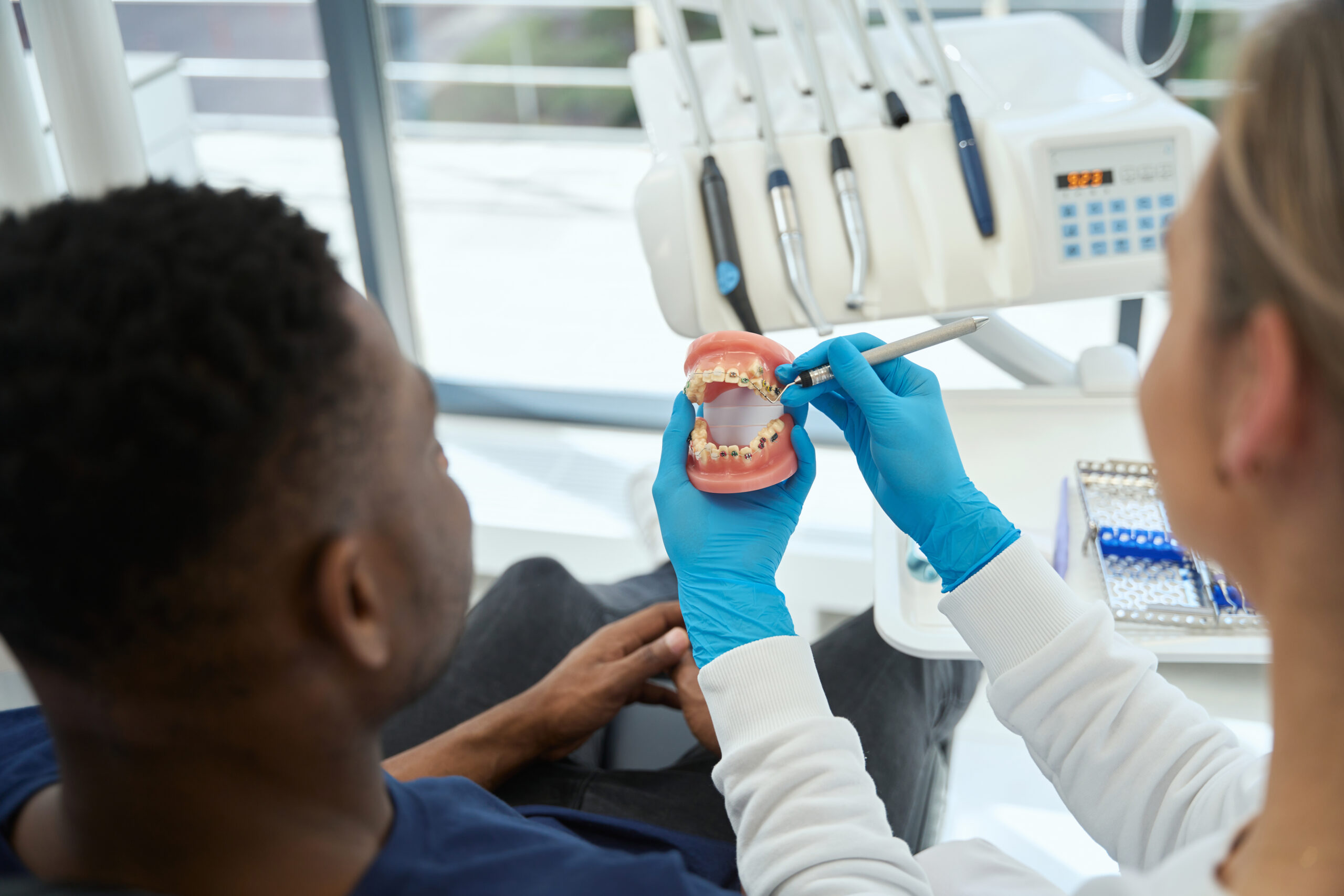Dental implants types have transformed modern dentistry and boast an impressive 98% success rate. Missing teeth replacement options might have led you to learn about these remarkable titanium posts that work as artificial tooth roots.
Dental implants provide the closest match to healthy, natural teeth. These titanium posts create permanent bases for fixed replacement teeth when surgeons place them into your jawbone beneath the gum line. Proper care helps them last a lifetime[-3], which makes dentistry’s gold standard.
Several dental implant types exist, but endosteal and subperiosteal implants stand out as the primary choices[-3]. Endosteal implants remain the most accessible to more people, though your specific needs might point to a different option. All-on-four treatments can replace an entire arch with just four implants, while specialized solutions handle complex cases. The right dental implant choice can give you new confidence and possibilities.
This piece explores various dental implant types to guide your decision about the best option for your needs.
Endosteal Implants
Endosteal implants are the life-blood of modern dental implant technology and most dentists use them in restorative dentistry today. These implants work as artificial tooth roots that provide a sturdy foundation for replacement teeth and help keep jawbone health.
What is Endosteal Implant
The term “endosteal” means “in the bone,” which shows exactly how these implants work. Dentists surgically place these small, screw-like titanium posts right into your jawbone. Your implant body acts as an artificial tooth root that bonds with your natural bone tissue through osseointegration.
These implants create a secure biochemical bond by connecting straight to your jawbone, unlike other dental restoration options. A synthetic bone substitute called hydroxyapatite (HA) coats most implants and has up to 98% natural bone material. This special coating makes your jawbone think the implant is natural bone tissue, which helps it integrate better and stay stable.
You can use each implant to support one or more prosthetic teeth, making them work well for different tooth replacement needs. Endosteal implants offer a reliable solution whether you need to replace one tooth or several adjacent teeth.
Who should think about Endosteal Implants
Not everyone can get endosteal implants. The best candidates usually meet these key criteria:
- Good general and oral health
- Healthy gum tissue with no periodontal disease
- A fully grown jawbone
- Enough bone density and volume in the jaw
- Can’t or won’t wear dentures

More than that, patients who used bridges or dentures before often make great candidates to upgrade to endosteal implants. Your lifestyle plays a role too – to name just one example, see how tobacco users have higher failure rates. Some medical conditions like uncontrolled diabetes or osteoporosis might affect your eligibility.
Your dentist will get a full picture of these factors during your consultation through detailed examination, including X-rays or 3D imaging to check your jawbone’s structure and density.
Endosteal Implant procedure overview
The endosteal implant process takes several months and has multiple stages:
- Original consultation and planning: Your dentist checks your oral health, looks at your medical history, and creates a treatment plan just for you.
- Surgical placement: The surgeon numbs the area, cuts your gum to see the jawbone, drills precise holes, and puts the titanium implant posts deep into the bone. Then they stitch your gum over the implant.
- Healing and osseointegration: This vital phase takes about 2 to 6 months as your jawbone grows around and joins with the implant. You might wear temporary dentures during this time to look better.
- Abutment placement: After integration finishes, the surgeon adds a small connector piece (abutment) to the implant that sticks out above your gumline. This part will hold your prosthetic tooth.
- Crown placement: Your dentist attaches a custom-made crown to the abutment. This prosthetic tooth matches your natural teeth’s color and shape.
You’ll have some swelling, discomfort, and maybe minor bleeding during recovery – these normal effects usually go away within days.
Pros and cons of Endosteal Implants
Pros:
- Soaring win rate—over 95%
- Works and looks like natural teeth
- Keeps your jawbone healthy by stopping bone loss
- One implant can support multiple prosthetic teeth
- No need to change nearby healthy teeth
Cons:
- Costs more upfront than other tooth replacement options
- Needs enough jawbone density (might need bone grafting if there isn’t enough)
- Requires surgery and recovery time
- Takes several months from start to finish
- Not right for everyone, especially those with certain health conditions
Endosteal Implant pricing
Endosteal implants are a big investment in your oral health. They cost more upfront than bridges or dentures because they last longer and work better.
A single endosteal implant in India costs between ₹30,000 to ₹50,000, not counting the crown or abutment. Prices change based on where you live, your dentist’s experience, materials used, and whether you need extra procedures like bone grafting.
Note that these implants often become budget-friendly over time compared to other options that need replacing more often.
Longevity and care for Endosteal Implants
Endosteal implants can last your whole life with good care. Their 97% success rate after 10 years shows how well they work. Notwithstanding that, you need to take good care of them:
- Brush twice daily and floss every day
- See your dentist regularly for checkups and cleanings
- Stay away from hard or very chewy foods that might damage the implant
- Don’t use tobacco as it raises failure risk by a lot
- Use antibacterial mouthwash to keep the area around implants clean
Right after surgery, you’ll need to follow specific care instructions. These usually include taking antibiotics, avoiding hard exercise, and eating soft foods for a while.
Dental implants can’t get cavities like natural teeth. However, they can still have problems with gum disease and other issues without proper care. Good maintenance helps your implant stay functional and attractive for decades.
Subperiosteal Implants
Subperiosteal implants offer a specialized solution alongside endosteal implants for patients with unique dental needs. These distinctive dental implants rest on top of the jawbone but beneath the gum tissue. They provide another way to restore teeth if you have specific anatomical limitations.
What is Subperiosteal Implant
“Subperiosteal” means “under the periosteum,” which explains how these implants work. Unlike endosteal implants that go into the jawbone, subperiosteal implants have a custom-made metal framework that sits on top of the jawbone beneath the periosteum (the thin membrane covering the bone). The framework has posts that come through the gum tissue to support prosthetic teeth.
These implants became popular in the 1970s, and their design has changed a lot since then. The first versions were made from Vitallium—an alloy with 60% cobalt, 30% chromium, and 10% molybdenum. Modern subperiosteal implants now use titanium, after titanium-based endosseous implants proved successful in the 1980s.
The structure has primary struts (the outer metal framework), secondary struts (which strengthen and connect the primary parts), and transmucosal abutment posts that attach to prosthetic teeth. These parts work together to create a stable base for replacement teeth without needing direct bone integration.
Who should consider Subperiosteal Implants
Subperiosteal implants work best for patients who can’t use traditional implant options. You might be a good candidate if you:
- Don’t have enough jawbone density or volume
- Can’t or don’t want to have bone grafting procedures
- Lost significant bone due to periodontal disease, trauma, or aging
- Have conditions that limit your body’s healing or bone reshaping
- Need quick solutions for missing teeth

These implants help patients with atrophic jaws (severely resorbed jawbone) when other anchoring methods don’t work. Older patients often benefit from them because they tend to have more bone loss and might not be ready for extensive surgery.
Subperiosteal Implant procedure overview
The procedure has evolved from its two-surgery approach to modern, less invasive techniques:
- Initial consultation and imaging: Your dentist examines your mouth and uses advanced imaging like CT scans to design precise implants.
- Custom framework design: Dentists use computer-aided design and manufacturing (CAD-CAM) to create a custom digital model that fits your jaw perfectly. Modern techniques use direct metal laser sintering (DMLS) to 3D-print the framework.
- Surgical placement: The surgeon numbs the area and makes a cut in your gum tissue to see the jawbone. They place the custom-made metal framework over the jawbone with posts coming through the gum tissue.
- Healing period: The surgeon stitches the gum tissue around the posts. You’ll need several weeks to heal. Your gums will form around the framework during this time.
- Prosthetic attachment: After healing, permanent artificial teeth attach to the posts.
Modern methods now skip the need for direct bone impressions during first surgery. Advanced imaging and digital design have replaced this step.
[Continued in next part due to length…]
[Note: I can continue with the rest of the text if needed, maintaining the same humanized approach while preserving technical accuracy]
Zygomatic Implants
Zygomatic implants offer a remarkable solution to patients who don’t have enough bone for regular implants. Professor P-I Brånemark brought these specialized implants to the dental world in the late 1980s. These implants anchor into the zygomatic bone (cheekbone) instead of the maxilla. This breakthrough created new possibilities for patients who couldn’t get implant treatment before.
What is Zygomatic Implant
Zygomatic implants stretch longer than conventional dental implants and secure themselves into the dense zygomatic bone rather than the upper jawbone. The length ranges from 30 to 52.5 mm. This extra length helps them bypass areas where bone loss exists by reaching into the stable, dense cheekbone.
These implants can sit at an angle to make the best use of existing bone structure. The zygomatic bone’s dense quality and cortical nature surpass the posterior maxillary bone. This provides excellent stability when placing implants. The implant head comes engineered to attach prosthesis at a 45-degree angle to its long axis.
Who should think over Zygomatic Implants
Dental experts created zygomatic implants specifically for people who can’t get traditional implants. The best candidates include:
- Patients who’ve lost much bone in their upper jaw
- People who aren’t right for bone grafting procedures
- Those whose previous grafts or implants didn’t work
- Patients who want to avoid staged bone graft procedures
- People with conditions that might make traditional bone grafting difficult
- Patients missing upper teeth due to trauma, tumor removal, or birth defects
Missing teeth lead to more bone loss over time. This makes traditional dental implants harder to place. So, zygomatic implants bring hope to people who might not have other permanent tooth replacement options.
Zygomatic Implant procedure overview
Placing zygomatic implants needs complex surgery. Most surgeons use general anesthesia because the procedure takes time and presents challenges. Experienced surgeons can also do this under local anesthesia.
The surgery needs detailed planning:
- The original consultation and CT/CBCT imaging show maxillary and zygomatic bone volume
- Doctors check for existing sinus problems
- They create custom treatment plans, sometimes using special software
The surgery follows these steps:
- Surgeons make exact incisions to reach the zygomatic bone
- They carefully drill and place implants using different approaches (intrasinus, extra-sinus, or the zygomatic anatomy guided approach)
- Patients might get temporary dentures right after surgery
Patients usually need a couple of days to rest after surgery. Doctors prescribe medicine to reduce swelling or irritation. Full healing takes 3-6 months.
Pros and cons of Zygomatic Implants
Pros:
- No need for bone grafting or sinus lift procedures
- Treatment finishes faster than conventional implants with bone grafting
- Patients can get same-day dentures
- Success rates reach 96-98%
- Many cases work right away
Cons:
- Surgery needs special expertise
- Complications like sinusitis might occur (14.2% after 5 years)
- Risks include nerve damage, orbital injury, or oro-antral fistula formation
- Costs more than traditional dental implants
- Speaking and cleaning teeth might be harder
Zygomatic Implant pricing
Zygomatic implants cost different amounts based on the protocol, surgeon’s expertise, and location. A single implant in India costs between ₹50,000 to ₹90,000.
Full arch restoration using these implants might cost ₹3 to ₹7 lakh per jaw. Sometimes this includes both conventional and zygomatic implants. Hyderabad & Kochi’s prices start with an extra ₹60,000 depending on the protocol.
The upfront cost might seem high, but many patients find it saves money compared to getting bone grafts and conventional implants together.
Longevity and care for Zygomatic Implants
These implants show great success rates – over 96% survive past 6 years. Loading them right away works better (98.1% survival) than waiting (95%).
Good care helps these implants last for decades. Here’s how to get the most from your implants:
- See your dentist regularly
- Keep your mouth clean by brushing, flossing, and using antibacterial mouthwash
- Follow all after-surgery instructions
- Stay away from tobacco and drink less alcohol
- Eat soft foods for two weeks after surgery before trying harder foods
Sinusitis stands out as the biggest long-term problem. It can show up years after getting implants. But with proper care and regular checkups, these implants transform lives for patients who’ve lost lots of upper jaw bone.
Mini Dental Implants
Mini dental implants are a new addition to dental implant options that provide a less invasive way to replace teeth. These tiny titanium posts have become popular because they’re easier to place and work well for patients who can’t get traditional implants.
What is Mini Dental Implant
Mini dental implants (MDIs) are much smaller than regular implants. They’re about as thick as a toothpick, measuring less than 3mm in diameter. These implants come as one piece with a solid, screw-like titanium post that has a ball-shaped end sticking above the gumline.
The design is different from traditional two-piece implants. MDIs combine the implant post and abutment into one piece. This simplified design works great in areas where space or bone volume is limited.
Who should consider Mini Dental Implants
Mini dental implants work best for:
- Patients who lack enough bone for traditional implants
- People who can’t or don’t want bone grafting procedures
- Those who need stable dentures that won’t slip during eating and speaking
- Patients with small teeth or narrow gaps needing replacement
- People looking for quick, minimally invasive procedures
Mini implants aren’t right for everyone. People should avoid this treatment if they have uncontrolled diabetes, advanced gum disease, hemophilia, or bone disease. The risks are also higher for smokers and patients taking blood thinners.
Mini Dental Implant procedure overview
The procedure is straightforward:
- Planning: X-rays or CT scans help determine the best implant placement
- Preparation: The area gets numbed with local anesthesia
- Placement: A small hole in the jawbone allows direct implant insertion through the gum
- Completion: The implant is secured, and often the new tooth can be attached right away
The procedure rarely needs cuts or stitches, which speeds up recovery. Most patients get back to their routine within 1-2 days.
Pros and cons of Mini Dental Implants
Pros:
- Minimally invasive surgery with less discomfort
- Bone grafting usually isn’t needed
- Costs less than traditional implants
- Quick recovery
- New teeth can often be attached immediately
Cons:
- Not as durable as traditional implants
- Might need replacement after 5-10 years
- Size limits where they can be used
- We need more research about long-term results
- Risk of breaking during placement
Mini Dental Implant pricing
Mini dental implants cost less than traditional ones. In India, you’ll pay between ₹42,190 and ₹126,570 per implant. A full lower denture supported by four to six mini implants averages around ₹370,767.
Prices vary based on:
- Where you live
- Your dentist’s experience
- How many implants you need
- Extra procedures
- Material quality
Longevity and care for Mini Dental Implants
These implants usually last 5-10 years, but good care can make them last much longer. Some patients have had their implants for decades.
Tips to make them last:
- Use a soft-bristled toothbrush twice daily
- Clean around the implant with floss every day
- Rinse with antimicrobial mouthwash
- Cut down on smoking and alcohol
- Use a night guard if you grind your teeth
- See your dentist regularly
The rubber O-rings on dentures that fit around mini implant balls need replacement as they wear out. You’ll need to replace these rings more often if you frequently remove and put back your dentures.
All-on-4 Dental Implants
The groundbreaking All-on-4 dental implant technique is a chance to transform dental implant treatment. This method uses just four carefully positioned implants to support a full arch of teeth.
What is All-on-4 Dental Implant
All-on-4 restores a full arch by using only four dental implants per jaw to support a complete set of prosthetic teeth. Traditional implants might need 8-10 posts per arch, but All-on-4 places two implants vertically at the front of the jaw and two at a 45° angle in the back. The angled placement creates maximum contact with available bone and eliminates the need for bone grafting in many cases.
Who should think about All-on-4 Implants
The best candidates are:
- People who have lost most or all teeth
- Patients without enough bone density for standard implants
- People with osteoporosis
- Patients who want to avoid bone grafting
- Anyone looking to replace removable dentures
Some patients might not qualify if they have uncontrolled diabetes, smoke heavily, or have medical conditions that slow healing.
All-on-4 Implant procedure overview
The process starts with 3D imaging to plan the perfect implant placement. The surgery day includes:
- Placing four titanium implants in key spots in the jawbone
- Adding abutments and a temporary acrylic bridge
- A healing period of 4-6 months while bone fuses with implants
- Switching the temporary bridge for a permanent one
Most patients can walk out with new teeth the same day as their surgery.
Pros and cons of All-on-4 Implants
Pros:
- A fixed solution that stays in place
- No movement like regular dentures
- Quick treatment without bone grafting
- Success rate of 98.2% in the lower jaw
- Stops facial sagging and bone loss
Cons:
- Speech might change temporarily
- Some discomfort at first
- Small risk of implant failure (about 5%)
- Costs more upfront than removable options
All-on-4 Implant pricing
All-on-4 implants in India cost between ₹3,00,000 to ₹6,50,000 per arch. Prices vary worldwide, with US costs ranging from $25,000 to $34,000 per arch. The final price depends on material quality, clinic location, and your dentist’s expertise.
Longevity and care for All-on-4 Implants
All-on-4 implants can last decades with good care. Research shows they have a 97-98% survival rate over 10 years. Here’s how to make them last:
- Brush twice daily where the bridge meets your gums
- Clean under the prosthesis with a water flosser
- See your dentist every 6 months
- Stay away from hard or sticky foods
Your titanium implants might last forever, but the prosthetic teeth usually need maintenance or replacement after 10-15 years.
Comparison Table
| Implant Type | Description/Structure | Primary Candidates | Success Rate/Longevity | Cost Range (India) | Main Advantages | Main Disadvantages |
| Endosteal Implants | Titanium posts shaped like screws that doctors surgically place into the jawbone | Patients with healthy gums, good oral health and enough bone density | 95%+ success rate; can last lifetime | ₹30,000-50,000 per implant | Looks and works naturally, maintains jawbone health, proven track record | Costs more upfront, needs adequate bone structure, takes longer to complete |
| Subperiosteal Implants | Metal framework placed beneath gum tissue but on top of the jawbone | Best suited for patients who lack bone density or prefer to avoid bone grafts | 97.8% survival rate at 21.4 months; 10-15 years typical lifespan | ₹30,000-65,000 per implant | Skips bone grafting, fits each patient’s needs, faster treatment time | Surgery complexity, higher chances of infection, limited research on long-term results |
| Zygomatic Implants | Extended implants that anchor into the cheekbone | Suitable for patients with major upper jaw bone loss who cannot get bone grafts | 96-98% success rate at 6 years | ₹50,000-90,000 per implant | No bone grafting needed, patients can use teeth right away | Complex surgical process, risk of sinus issues, premium pricing |
| Mini Dental Implants | Single-piece implants with small diameter (<3mm) | Works well for patients who have lost bone or need stable dentures | 5-10 years typical lifespan | ₹42,190-126,570 per implant | Minimal invasion, budget-friendly, quick healing | Less stable, might need earlier replacement, limited use cases |
| All-on-4 Implants | System using four implants to support a full set of teeth | Perfect for patients missing most or all teeth who want to avoid bone grafts | 97-98% survival rate at 10 years | ₹3,00,000-6,50,000 per arch | Permanent solution, stops bone loss, immediate results | Speech adjustments needed at first, expensive upfront cost, temporary pain |
Conclusion
The right dental implant for you depends on your oral health needs, bone density, budget, and priorities. We’ve looked at several dental implant options that work for different clinical situations. Endosteal implants are still the best choice for patients with good jawbone density. Subperiosteal implants work well for those who don’t have enough bone volume. Zygomatic implants give hope to patients with severe upper jaw bone loss who had few options before.
Mini dental implants are less invasive and cost less, but they might not last as long as traditional options. The All-on-4 technique has changed full-arch restoration. It uses just four implants to support a complete set of teeth and eliminates the need for extensive bone grafting.
You should schedule a detailed consultation with a qualified implant dentist who can look at your specific case. The dentist will check your oral health, bone structure, and medical history to suggest the best implant type for you. Look beyond the original cost – think about long-term value, upkeep needs, and possible complications when you make your choice.
Dental implants have given countless people their function and confidence back. Your implant treatment’s success depends a lot on proper aftercare and maintenance. Regular dental visits, good oral hygiene, and staying away from harmful habits like smoking will help your investment last for years, maybe even decades.
Whatever implant type you pick, your experience toward a restored smile starts with learning about and understanding your options. This piece should help you make an informed choice about your dental health. Your perfect smile is waiting!
FAQs
Q1. What is considered the best type of dental implant?
Endosteal implants are generally regarded as the best type of dental implant. They are surgically placed directly into the jawbone, providing excellent stability and stimulating bone growth. These implants offer a high success rate and can last a lifetime with proper care.
Q2. Are titanium or zirconia implants better?
Both titanium and zirconia implants have their advantages. Titanium implants have a longer track record of success and are more versatile. Zirconia implants are newer but offer excellent esthetics and are metal-free. The choice depends on individual needs and preferences, but titanium remains the most widely used and proven option.
Q3. What are the advantages of All-on-4 dental implants?
All-on-4 implants offer several benefits, including full-arch restoration with just four implants, reduced need for bone grafting, and the possibility of immediate loading. They provide a fixed, non-removable solution that prevents facial sagging and bone loss while offering a high success rate.
Q4. Who are good candidates for mini dental implants?
Mini dental implants are suitable for patients with significant bone loss who cannot receive traditional implants, those seeking denture stabilization, and individuals looking for a quicker, less invasive procedure. They’re also ideal for replacing small teeth or filling narrow spaces.
Q5. How long do dental implants typically last?
With proper care and maintenance, dental implants can last a very long time. Endosteal implants have the potential to last a lifetime, while other types like mini implants may need replacement after 5-10 years. Regular dental check-ups and good oral hygiene are crucial for maximizing the longevity of any dental implant.








